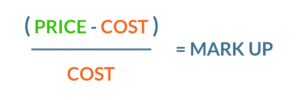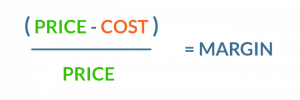Mark Up and Margin
If you’ve heard other business owners talking about the difference between Mark Up and Margin but you’re not sure what that means, then you’ve come to the right place!
It all starts with thinking differently about how you price your products and services. And that’s a big deal because how you price determines how profitable your business is.
Most business owners start with a Mark Up but soon discover moving to a Margin-based model not only makes their business more profitable, it also provides a more solid foundation for growth.
What’s the difference between Mark Up and Margin?
Mark Up
Mark Up ensures you get revenue from each and every sale. It’s great if you’re a newer business that’s keenly aware of costs and need to ensure those costs are covered while you’re still learning about the kind of revenue you can generate.
As you get to know your business better and start looking more closely at your business reports, understanding your Margin will tell you how much actual cash profit you need to run your business and make it grow.
Put simply, Mark Up is a “cost plus” model, while Margin focuses on “value based” pricing. Because if you provide value to your customers, all the other pieces of your business puzzle fall into place.
How does Mark Up work?
Mark Up is the amount you add to your costs – such as materials – to arrive at your selling price.
The Mark Up formula looks like this:
Mark Up is usually expressed as a percentage, which means you can guarantee a proportional amount of revenue even if your base cost fluctuates or increases.
While a Mark Up generates ‘top line’ revenue, it doesn’t always guarantee that your business is making enough profit to survive or grow.
Margin
How does Margin work?
Margin is a different way of looking at your pricing. It helps you to focus on the profit you earn as a percentage of the selling price, rather than just on covering costs.
While Mark Up uses ‘Cost’ as the divisor, Margin uses ‘Price’. It’s a subtle difference, but one that can make a noticeably big difference.
Margin can be expressed as a specific dollar amount or as a percentage.
Working with a Margin model means you can guarantee the amount of profit your business will make for you – the shareholder – and to make good decisions about investing in the foundation of your business so it can grow.
Should you use a Mark Up or a Margin?
We encourage the businesses we work with to use Margins rather than Mark Ups for a range of reasons:
Margins make it easier to price your products and services at the right level for your customer base. Setting your prices too high can lead to lost sales, while setting them too low results in lost profit.
Margins work better for businesses that want to grow. Investing in your business can increase your costs and overheads in ways that working on a Mark Up doesn’t account for.
Conclusion
It challenges business owners to think differently about the way the business is running because that’s how you get different results!














